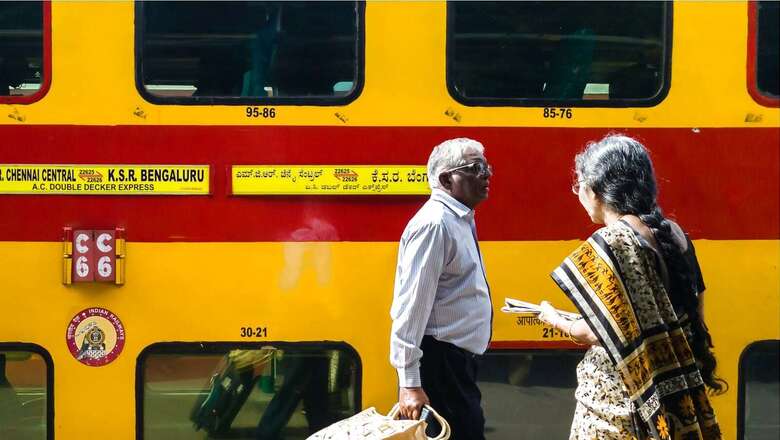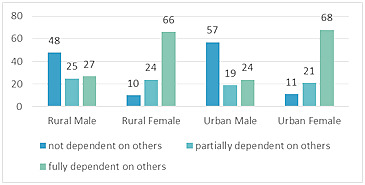
views
India has nearly 67% of its population in the 15 to 64 years age group. As a result, the policy focus has mainly been on how to reap the benefits of the country’s demographic dividend. However, the policy discussions often miss the future implications of such an age structure of the population.
The population of elderly persons aged 60 years and above has steadily increased since 1961. This is mainly attributed to improvement in economic well-being and healthcare facilities, leading to declining death rates, falling fertility rates, and rising life expectancy. According to the Report of the Technical Group on Population Projections, India’s elderly population is currently estimated to be around 13.8 crore. This number is expected to be close to 19.3 crore in 2031.
Furthermore, according to the Census 2021 projections, the elderly female and male populations stood close to 7.1 crore and 6.7 crore, respectively. This indicates that elderly females outnumber their male counterparts. This outnumbering is projected to strengthen with time. The larger population of elderly females is a sign of feminisation of the elderly population in the country, which brings its own unique set of challenges.
Economic Concerns
Despite India’s significant economic progress in recent decades, women’s economic participation is low. According to the Periodic Labour Force Survey 2019-20, women’s labour force participation rate was lower than men in all the age groups. For instance, for women aged 15 years and above, the labour force participation rate was around 30%. For men in the same age bracket, this rate was around 77%.
The underrepresentation of women in paid work has long term implications. One of them is that older women are less likely to have savings and financial support such as pension or retirement benefits. Therefore, they are economically dependent on others. As per the NSS 75th Round, only 10% of elderly women in rural areas and 11% of elderly women in urban areas were economically independent. Elderly men fared much better than elderly women in this aspect.
Figure 1: Percentage distribution of the elderly population by the state of economic independence

Source: NSS Report no. 586 – Health in India
According to the recent Global Gender Gap Report, India ranks 135th out of 156 countries in wage equality for similar work. Lower lifetime earnings due to the pervasive gender wage gap imply that even the small percentage of women who receive wages for their work will have less money saved for retirement than men.
Women also require financial knowledge to have a financially secure future. Unfortunately, financial illiteracy is particularly pronounced among women, leaving them at a disadvantage. According to a recent report, only 20% of women in India can be considered financially literate.
Globally, life expectancy for males was nearly five years lower than for females. In India, in 2019, the life expectancy of males and females stood at 69.5 years and 72.2 years, respectively. When women’s longer life expectancy is taken into account, the economic concerns become even more critical to address. This is because longer life expectancy implies that women need a larger pool of savings than men.
Social Concerns
India is home to the highest number of widows in the world. According to the World Widows Report from the Loomba Foundation, there are close to 5 crore widowed women in India. Due to the rising population of elderly women and the longer life expectancy of women in general, the prevalence of widowhood among women is expected only to increase. While widowhood is associated with complexities for both men and women, women tend to be more adversely affected. Widowed women suffer social stigmatisation and discrimination. Additionally, the pattern of residence in the country is mainly patrilocal. This isolates widows and adds to their social and economic marginalisation.
Furthermore, inheritance norms in the country favour men over women. Asset ownership and the right to property are essential for women’s social and economic well-being, and once widowed, women often confront denial of these rights.
Elderly women are largely dependent on their families for their social well-being. With the nuclearisation of families gaining traction and increasing migration of the working-age group population to cities, elderly women are also facing long periods of social isolation. Adding to the vulnerability of elderly women is the abuse and ill-treatment that they face. This abuse deprives them of leading a dignified life. Adding to their perils, women are disadvantaged compared to men when it comes to access to education. Due to this, elderly women are likely to be unaware of their rights and laws which are there to help them.
Health Concerns
Along with a changing population structure, India is also going through an epidemiological transition. This refers to a move from a disease pattern dominated by infectious diseases to one dominated by non-communicable diseases (NCDs). NCDs include chronic respiratory diseases, heart ailments, diabetes, etc., and their prevalence increases with age. This indicates that India is shifting a large share of the country’s burden of disease to the older population.
In order to experience healthy ageing, women need to have access to affordable and adequate healthcare services throughout their lives. Unfortunately, this has not been the case for Indian women. Due to the inequality in access to education, Indian women are likely to be unaware of health risk factors. Furthermore, they are also less likely to engage in healthcare-seeking behaviour. This coincides with the observation that healthcare expenditure on females is systematically lower than on males across all demographic and socio-economic groups.
The breakdown of the joint family structure has meant that traditional family-based care is also not as readily available as it was in the past. The trend of elderly living alone or living only with a spouse is increasing, especially in urban areas. This means that the elderly population’s traditional support system is weakening, and they will have lesser access to care in the future.
Way Forward: Closing Gender Gaps
With an increasingly female ageing population, India needs to implement policies that ensure gender equity for the elderly population. The challenges faced by elderly women are primarily due to the gender-based discrimination experienced by them throughout their lives. In order to ensure healthy and secure aging for women, it is critical to have policies that are aimed at closing the gender gaps that exist at all stages of the life course.
Female workforce participation must be encouraged so that the future generations of older women can become economically independent. Since a significant chunk of the work women undertake, such as their unpaid care work, is not formally recognised, they remain ineligible for many social protection programmes. Therefore, gender-responsive social protection schemes that consider such vulnerabilities are the need of the hour. Taking steps to improve literacy levels among women will help in increasing the awareness and uptake of such schemes. This will help women enhance their financial security at old age.
While it is true that the prevalence of NCDs is increasing in India, infectious diseases still pose significant challenges to the public health system. This causes India to bear a double burden of disease. The country’s health policies need to be redesigned so that both categories of diseases get due attention from policymakers. Since women face inequalities in access to health interventions, a gendered approach to intervention development would ensure that women experience healthy ageing.
The author is a research associate at SPRF, a policy think tank seeking to make public policy research holistic and accessible. The views expressed in this article are those of the author and do not represent the stand of this publication.
Read all the Latest Opinions here

















Comments
0 comment